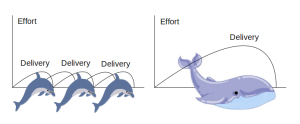Guest Post by Martin Webster.
Organisations must become increasingly able to change quickly and easily. The business must be flexible yet capable of implementing and sustaining change. Change has to be built into the way businesses work.
However, many organisations have problems with the way they tackle change. These problems are usually related to people, processes, systems, technology or structure. Change is complex. Change is wicked! And the pace and scale of change today can overwhelm organisations.
Sustaining Change
Projects are key to creating beneficial change. They are the vehicles for managing and implementing change. Those organisations that recognise project management is a core capability (or competence) are most likely to find success in sustaining change.
Successful business change projects have the following characteristics.
A Business-led Change
A single project team. That is, a team that is business-led. One that comprises of all the required resources from the business, human resources, information technology and so on. Ideally, team members should be collocated and allocated to the project full-time. This encourages communication and helps to build strong relationships.
Benefits Realisation
Business change is about delivering benefits. The project team is responsible for delivering clearly specified benefits to the business not for creating systems, structures nor introducing technologies. There should be no other success criteria! Projects should always be driven by benefits that support strategy.
A Sense of Urgency
Executive management describes the business need—why the project is necessary—from the outset. Their mandate will also specify the time-scale within which the project must deliver the benefits. What’s more, successful organisations set a challenging schedule and stick to it—even when expert opinion suggests this is unachievable. Change should be delivered with urgency and in no more than nine months.
Time-Boxing
Detailed analysis has the effect of putting the brakes on change. Therefore, the idea of time-boxing is used to push the project team to make decisions about what is really needed. Successful businesses break tradition and create a sense of urgency when delivering change.
Quick Wins
Large scale change needs momentum plus a sense of achievement and bags of optimism. Time-boxing encourages quick wins ensuring results are achieved quickly. Instead of detailed analyses and the preparation of a hefty business case or full requirements specifications the project team is moved to change and learns what is really required through a series of iterations—breaking large scale change into smaller chunks and success stories.
Dolphins Not Whales
Thus, large scale projects are broken down into a series of shorter steps or phases. Each step will deliver benefits and move the organisation to sustaining change. It is urgency that sustains change and this is only possible when results are achieved rapidly. Not only does this give recognition and encouragement to those working hard to accomplish change it also builds faith in the change effort.
David Feeny—a prominent British academic and authority on business transformation—first introduced the concept of dolphins not whales. It effectively shows people how sustaining change should be implemented. That is, creating a climate for change by increasing urgency and engaging and enabling the organisation through short-term wins.
Dolphins, not whales is a great way to grasp what is at the heart of change. When leading change use this to win hearts and minds.
Have Your Say
What approach do you use to implement large-scale change? Do you take an incremental approach or favour the monolithic project? Please join the discussion.
This is a guest Post by Martin Webster (Original post can be found at Leadership Thoughts – Reproduced with permission).
Image: NOAA’s National Ocean Service.
Martin Webster is Design and Commissioning Manager at Leicestershire County Council in the United Kingdom. He is an engineer and Chartered IT Professional with over 20 years’ experience of business change, project management and solution architecture. Martin works with senior people to solve problems. People remember him because he recommends and implements practical, focused solutions. LinkedIn profile: http://uk.linkedin.com/in/martinwebster/


Discussion
Trackbacks/Pingbacks
Pingback: Why you should care about Organisational Change? | Martin Davis' Blog - December 6, 2013